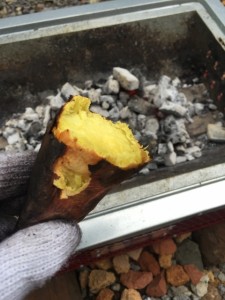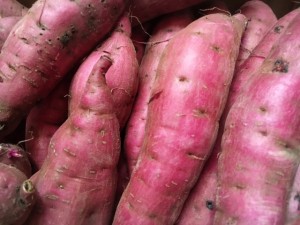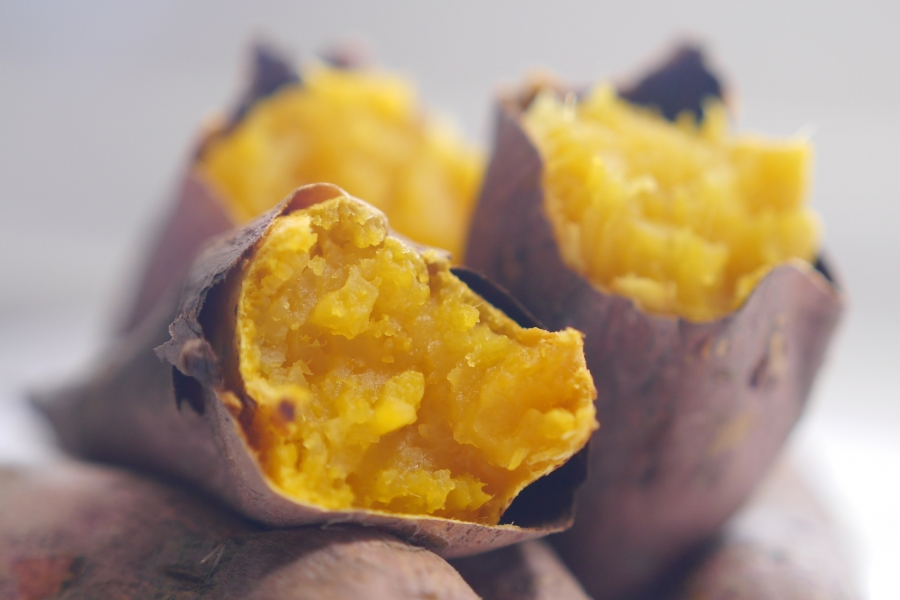Contents:
- The Story of Yakiimo
- The Birth of Yakiimo
- Healthy Snack
- How to Roast Yakiimo
- Health Benefit of Yakiimo
- Kinds of Sweet Potatoe
The Story of Yakiimo
We are amazed at the varieties of yakiimo that have become available in recent years, with their delightful aroma of malt sugar and as sweet and tasty as cake.
Improvements in the breeding of sweet potatoes, advancements in cultivation, curing, and storage technologies, and extensive research in roasting are behind the evolutionary changes of yakiimo.
The traditional types of yakiimo include potatoes roasted to the smooth, slightly dry texture favored in Kanto and those with the softer, moister texture eaten in Kansai and the south. With the availability of Naruto Kintoki, Beni Haruka, and Tanegashima Island’s Anno Imo, which boast the highest sugar concentrations, the softer types of yakiimo are now popular.
Sweet potatoes are said to have originated in Mexico or Central America. How they came to Japan was a mystery until recently, but researchers credible of which traces back to prehistoric Peru, from where sweet potatoes were reportedly brought to Easter Island and then to Polynesia around 1000 B.C.
Sweet potatoes were introduced to Japan after travel through a series of islands–arriving at Miyakojima Island in 1594, Okinawa Island in 1604, and Tanegashima Island in 1698. In 1705 they reached the land of the Satsuma Clan on the Japanese island of Kyushu. In 1734, sweet potatoes made it to the Edo metropolis, and farmers began to cultivate them.
Sweet potatoes were called Satsuma imo in Edo because they came from Satsuma, and kara imo in Satsuma because they arrived from the country of Kara (China). These name suggest how sweet potatoes had traveled.
The Birth of Yakiimo
Sweet potatoes saved the Japanese through various famines during the Edo era, and production grew as a substitute for rice. According to legend, the first yakiimo store opened in 1793 in Edo, and it became very successful. Subsequent to the start of the Pacific War in 1941, Japan suffered a period of food shortage. That shortage grew more severe during the post-war period.
Sweet potatoes became a staple for the Japanese people, and for many years they were a popular food item. In the 1970s, however, convenience stores and fast-food restaurants mushroomed and yakiimo stores quickly disappeared.
Healthy Snack
It wasn’t until recently that Japanese people began to see the sweet potato as a health food, and what used to be a substitute in hard times thus became a desired ingredient in healthy snacks like sweets and cakes. The transformation of sweet potatoes was made possible for several reasons, one of which was a series of breeding improvements. Beni Azuma, produced in Kanto, and Kokei 14 (the so-called Kintoki), grown in the south, triggered the boom in sweet potatoes. In fact, these two varieties account for approximately half of all production in Japan. Scientists have created many other famous varieties of sweet potatoes, such as Naruto Kintoki, from the Kintoki variety.
Further breeding improvements led to the birth of Beni Haruka, Purple Sweet Road, etc., and the golden era of moist yakiimo, represented by Anno Imo-from Tanegashima and grown under strict production controls–began.
The second reason behind the transformation of sweet potatoes was the advancement in production controls. To address the problem posed by the thin, breakable skins of freshly harvested sweet potatoes, a curing process was invented to form a corky structure under the skin, allowing the product to be stored for a longer period. The perfect storage facility was developed in which to mature sweet potatoes for long periods. This increased the starch content, and thus the sweetness. The maturation process was advanced by controlling storage period, temperature/ humidity, oxygen, and carbonic-acid gas levels specific to the variety and region of the potato. As tastier sweet potatoes that had been stored and matured for longer periods became available starting in the spring, yakiimo was no longer just a winter food made from sweet potatoes harvested in September or October. The new breeds of sweet potatoes were also resistant to storage at sub-zero temperatures after cooking, which made it possible for consumers the world over to enjoy yakiimo throughout the year. Indeed, yakiimo today is even enjoyed chilled in the summer.
How to Roast Yakiimo
 Temperature control is an important element of the roasting process, where an understanding of the relationship between temperature and sweetness is paramount. Potato starch is gelatinized at 140°F. When heated further to 149-167°F, gelatinized starch is hydrolyzed and broken down into malt sugar by the enzyme action of amylase, and voila! You have sweet yakiirno. The key is to roast the sweet potatoes at temperatures of 149 to 167°F for 30 to 60 minutes. Food manufacturers use a variety of equipment to make perfect yakiimo, but nowadays any home will have an oven or a toaster with a temperature-control function. With an understanding of the roasting principle, anyone can make tasty yakiimo.
Temperature control is an important element of the roasting process, where an understanding of the relationship between temperature and sweetness is paramount. Potato starch is gelatinized at 140°F. When heated further to 149-167°F, gelatinized starch is hydrolyzed and broken down into malt sugar by the enzyme action of amylase, and voila! You have sweet yakiirno. The key is to roast the sweet potatoes at temperatures of 149 to 167°F for 30 to 60 minutes. Food manufacturers use a variety of equipment to make perfect yakiimo, but nowadays any home will have an oven or a toaster with a temperature-control function. With an understanding of the roasting principle, anyone can make tasty yakiimo.
Health Benefit of Yakiimo
The greatest health benefit of yakiimo is that it regulates digestion. This results from the fact that the sweet potato is rich in dietary fiber and also because 50-60% of its malt sugar reaches the intestines, where it activates the enteric bacteria.
The heightened activity of these enteric bacteria activates the immune cells in the body to boost its ability to produce antibodies.
Kinds of Sweet Potatoe
Beni Haruka

Anno Imo

Kintoki
Popular in western Japan, this breed of sweet potato has spawned many famous varieties such as Naruto Kintoki. It’s perfect for yakiimo, steamed sweet potato, and sweet-potato paste. We grow our own Kintoki at Nijiya Farm and sell it fresh in the winter months, starting in November.
Purple Sweet Road
A cross between Kintoki and the purple potato, Purple Sweet Road has the tastiness of Kintoki and the high nutritional value of the purple potato. Rich in polyphenols, which are powerful antioxidants, this sweet potato is not only a powerful health supplement but is also a perfect ingredient for making delicious, beautiful yakiimo as well as sweet-potato jelly, puddings, candies, etc. Purple Sweet Road is grown at Nijiya Farm and is sold fresh and in processed foods.

